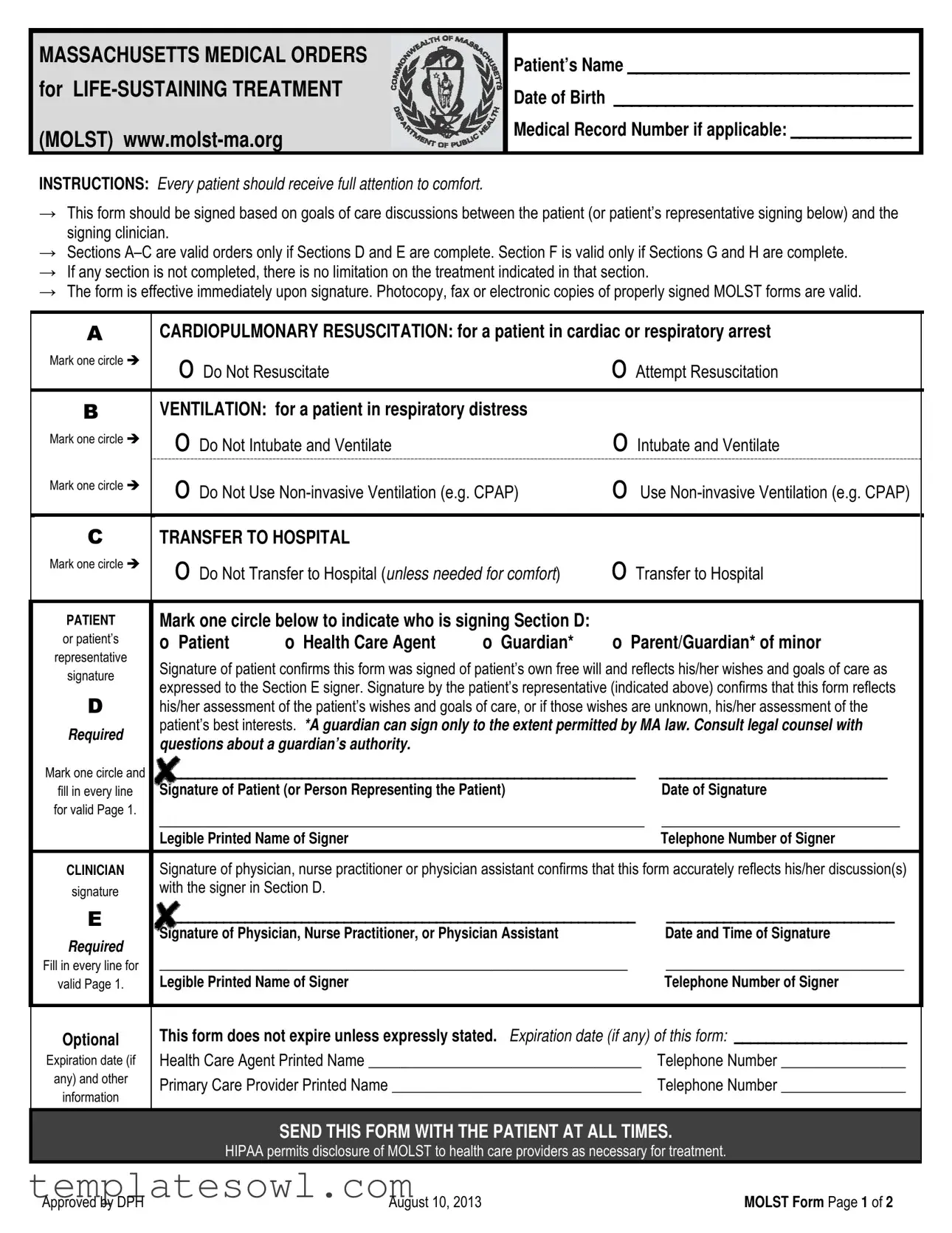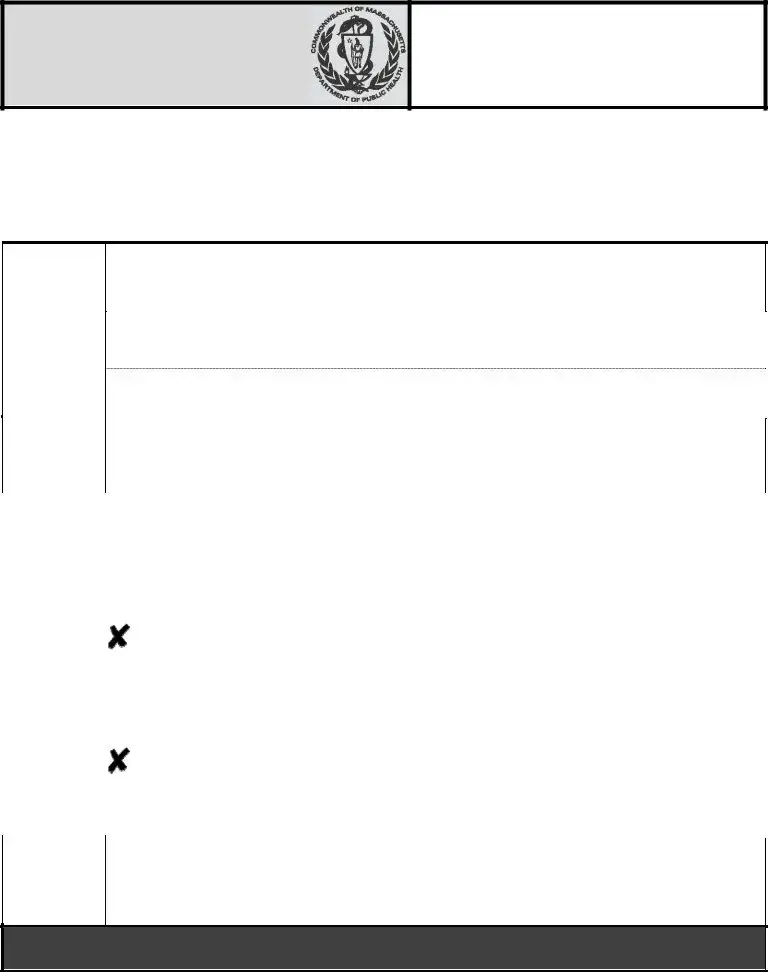MASSACHUSETTS MEDICAL ORDERS for LIFE-SUSTAINING TREATMENT
(MOLST) www.molst-ma.org
Patient’s Name _________________________________
Date of Birth ___________________________________
Medical Record Number if applicable: ______________
INSTRUCTIONS: Every patient should receive full attention to comfort.
→This form should be signed based on goals of care discussions between the patient (or patient’s representative signing below) and the signing clinician.
→Sections A–C are valid orders only if Sections D and E are complete. Section F is valid only if Sections G and H are complete.
→If any section is not completed, there is no limitation on the treatment indicated in that section.
→The form is effective immediately upon signature. Photocopy, fax or electronic copies of properly signed MOLST forms are valid.
ACARDIOPULMONARY RESUSCITATION: for a patient in cardiac or respiratory arrest
Mark one circle |
o Do Not Resuscitate |
o Attempt Resuscitation |
|
B |
VENTILATION: for a patient in respiratory distress |
|
|
Mark one circle |
o Do Not Intubate and Ventilate |
o Intubate and Ventilate |
|
|
|
Mark one circle |
o Do Not Use Non-invasive Ventilation (e.g. CPAP) |
o Use Non-invasive Ventilation (e.g. CPAP) |
|
|
|
|
|
|
|
CTRANSFER TO HOSPITAL
|
Mark one circle |
o Do Not Transfer to Hospital (unless needed for comfort) |
o Transfer to Hospital |
|
|
|
|
|
|
|
|
PATIENT |
Mark one circle below to indicate who is signing Section D: |
|
|
|
or patient’s |
o Patient |
o Health Care Agent |
o Guardian* |
o Parent/Guardian* of minor |
|
representative |
|
Signature of patient confirms this form was signed of patient’s own free will and reflects his/her wishes and goals of care as |
|
signature |
|
expressed to the Section E signer. Signature by the patient’s representative (indicated above) confirms that this form reflects |
|
|
|
D |
his/her assessment of the patient’s wishes and goals of care, or if those wishes are unknown, his/her assessment of the |
|
Required |
patient’s best interests. *A guardian can sign only to the extent permitted by MA law. Consult legal counsel with |
|
questions about a guardian’s authority. |
|
|
|
|
|
|
|
|
|
Mark one circle and |
___________________________________________________________________ |
________________________________ |
|
fill in every line |
Signature of Patient (or Person Representing the Patient) |
|
Date of Signature |
|
for valid Page 1. |
_________________________________________________________ |
____________________________ |
|
|
|
|
Legible Printed Name of Signer |
|
|
Telephone Number of Signer |
|
|
|
|
CLINICIAN |
Signature of physician, nurse practitioner or physician assistant confirms that this form accurately reflects his/her discussion(s) |
|
signature |
with the signer in Section D. |
|
|
|
|
E |
___________________________________________________________________ |
________________________________ |
|
Required |
Signature of Physician, Nurse Practitioner, or Physician Assistant |
|
Date and Time of Signature |
|
|
|
|
|
|
|
Fill in every line for |
_______________________________________________________ |
____________________________ |
|
valid Page 1. |
Legible Printed Name of Signer |
|
|
Telephone Number of Signer |
|
|
|
|
|
|
|
Optional
Expiration date (if
any) and other
information
This form does not expire unless expressly stated. Expiration date (if any) of this form: ______________________
Health Care Agent Printed Name ___________________________________ |
Telephone Number ________________ |
Primary Care Provider Printed Name ________________________________ |
Telephone Number ________________ |
SEND THIS FORM WITH THE PATIENT AT ALL TIMES.
HIPAA permits disclosure of MOLST to health care providers as necessary for treatment.
Approved by DPH |
August 10, 2013 |
MOLST Form Page 1 of 2 |
Patient’s Name: ______________________ Patient’s DOB ___________ Medical Record # if applicable__________________
FStatement of Patient Preferences for Other Medically-Indicated Treatments
INTUBATION AND VENTILATION
Mark one circle |
O Refer to Section B |
on |
|
O Use intubation and ventilation as marked |
|
O Undecided |
|
|
Page 1 |
|
|
in Section B, but short term only |
|
|
O Did not discuss |
|
|
|
|
|
|
|
|
NON-INVASIVE VENTILATION (e.g. Continuous Positive Airway Pressure - CPAP) |
|
Mark one circle |
O Refer to Section B |
on |
|
O Use non-invasive ventilation as marked in |
|
O Undecided |
|
|
|
|
|
Page 1 |
|
|
Section B, but short term only |
|
|
O Did not discuss |
|
|
DIALYSIS |
|
|
|
|
|
|
|
|
Mark one circle |
O No dialysis |
|
|
O Use dialysis |
|
|
|
O Undecided |
|
|
|
|
O Use dialysis, but short term only |
|
|
O Did not discuss |
|
|
|
|
|
|
|
|
|
ARTIFICIAL NUTRITION |
|
|
|
|
|
|
|
Mark one circle |
O No artificial nutrition |
|
O Use artificial nutrition |
|
|
O Undecided |
|
|
|
|
|
|
|
|
|
O Use artificial nutrition, but short term only |
|
O Did not discuss |
|
|
ARTIFICIAL HYDRATION |
|
|
|
|
|
|
|
Mark one circle |
O No artificial hydration |
|
O Use artificial hydration |
|
|
O Undecided |
|
|
|
|
|
|
|
|
|
|
|
|
|
|
|
|
|
|
O Use artificial hydration, but short term only |
|
O Did not discuss |
|
|
Other treatment preferences specific to the patient’s medical condition and care |
________________________________ |
|
|
_______________________________________________________________________________________________ |
|
|
_______________________________________________________________________________________________ |
|
|
|
|
|
|
|
PATIENT |
Mark one circle below to indicate who is signing Section G: |
|
|
|
|
or patient’s |
o Patient |
o Health Care Agent |
o Guardian* |
o Parent/Guardian* of minor |
|
representative |
|
|
|
|
|
|
|
|
|
|
signature |
Signature of patient confirms this form was signed of patient’s own free will and reflects his/her wishes and goals of care as |
|
|
expressed to the Section H signer. Signature by the patient’s representative (indicated above) confirms that this form reflects |
|
G |
his/her assessment of the patient’s wishes and goals of care, or if those wishes are unknown, his/her assessment of the |
|
patient’s best interests. *A guardian can sign only to the extent permitted by MA law. Consult legal counsel with |
|
Required |
|
questions about a guardian’s authority. |
|
|
|
|
|
|
|
|
|
|
|
Mark one circle and |
_______________________________________________________ |
____________________________ |
|
Signature of Patient (or Person Representing the Patient) |
|
|
Date of Signature |
|
fill in every line |
|
|
|
|
|
|
|
|
|
|
|
|
for valid Page 2. |
_______________________________________________________ |
____________________________ |
|
|
Legible Printed Name of Signer |
|
|
|
|
|
Telephone Number of Signer |
|
|
|
|
CLINICIAN |
Signature of physician, nurse practitioner or physician assistant confirms that this form accurately reflects his/her |
|
signature |
discussion(s) with the signer in Section G. |
|
|
|
|
|
H |
_______________________________________________________ |
____________________________ |
|
Signature of Physician, Nurse Practitioner, or Physician Assistant |
|
|
Date and Time of Signature |
|
|
|
|
|
Required |
_______________________________________________________ |
____________________________ |
|
Fill in every line for |
|
Legible Printed Name of Signer |
|
|
|
|
|
Telephone Number of Signer |
|
valid Page 2. |
|
|
|
|
|
|
|
|
|
|
|
|
|
|
|
|
|
|
|
|
|
|
|
|
|
Additional Instructions For Health Care Professionals
→Follow orders listed in A, B and C and honor preferences listed in F until there is an opportunity for a clinician to review as described below.
→Any change to this form requires the form to be voided and a new form to be signed. To void the form, write VOID in large letters across both sides of the form. If no new form is completed, no limitations on treatment are documented and full treatment may be provided.
→Re-discuss the patient's goals for care and treatment preferences as clinically appropriate to disease progression, at transfer to a new care setting or level of care, or if preferences change. Revise the form when needed to accurately reflect treatment preferences.
→The patient or health care agent (if the patient lacks capacity), guardian*, or parent/guardian* of a minor can revoke the MOLST form at any time and/or request and receive previously refused medically-indicated treatment. *A guardian can sign only to the extent permitted by MA law.
Consult legal counsel with questions about a guardian’s authority.
Approved by DPH |
August 10, 2013 |
MOLST Form Page 2 of 2 |
IMPORTANT INFORMATION ABOUT MASSACHUSETTS MOLST
The Massachusetts MOLST form is a MA DPH‐approved standardized medical order form for use by licensed Massachusetts physicians, nurse practitioners and physician assistants.
While MOLST use expands in Massachusetts, health care providers are encouraged to inform patients that EMTs honor MOLST statewide, but that systems to honor MOLST may still be in development in some Massachusetts health care institutions.
PRINTING THE MASSACHUSETTS MOLST FORM
⎯Do not alter the MOLST form. EMTs have been trained to recognize and honor the standardized MOLST form. The best way to assure that MOLST orders are followed by emergency medical personnel is to download and reproduce the standardized form found on the MOLST web site.
⎯Print original Massachusetts MOLST forms on bright or fluorescent pink paper for maximum visibility.
Astrobrights® Pulsar Pink* is the color highly recommended for original MOLST forms. EMTs are trained to look for the bright pink MOLST form before initiating life‐sustaining treatment with patients.
⎯Print the MOLST form (pages 1 and 2) as a double‐sided form on a single sheet of paper.
⎯Provide an electronic version of the downloaded MOLST form to your institution’s forms department or to personnel responsible for copying/providing forms in your institution.
FOR CLINICIANS: BEFORE USING MOLST
MOLST requires a physician, nurse practitioner, or physician assistant signature to be valid. This signature confirms that the MOLST accurately reflects the signing clinician’s discussion(s) with the patient. The MOLST form should be filled out and signed only after in‐depth conversation between the patient and the clinician signer.
Before using MOLST:
⎯Access the Clinician Checklist for Using MOLST with Patients at: http://www.molst‐ma.org/health‐ care‐professionals/guidance‐for‐using‐molst‐forms‐with‐patients.
⎯Listen to MOLST Overview for Health Professionals at: http://www.molst‐ma.org/molst‐training‐line.
⎯Access the MOLST website at: http://www.molst‐ma.org periodically for MOLST form updates.
⎯For more information about Massachusetts MOLST or the Massachusetts MOLST form, visit http://www.molst‐ma.org.
* Astrobrights® Pulsar Pink paper can be purchased from office suppliers, including:
Staples ‐ Item #491620 Wausau™ Astrobrights® Colored Paper, 8 1/2" x 11", 24 Lb, Pulsar Pink, in stores or at http://www.staples.com, and
Office Depot – Item #420919 Astrobrights® Bright Color Paper, 8 1/2 x 11, 24 Lb, FSC Certified Pulsar Pink, in stores or at http://www.officedepot.com.
August 10, 2013 |
MOLST Instructions Page 1 of 1 |



